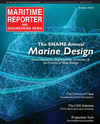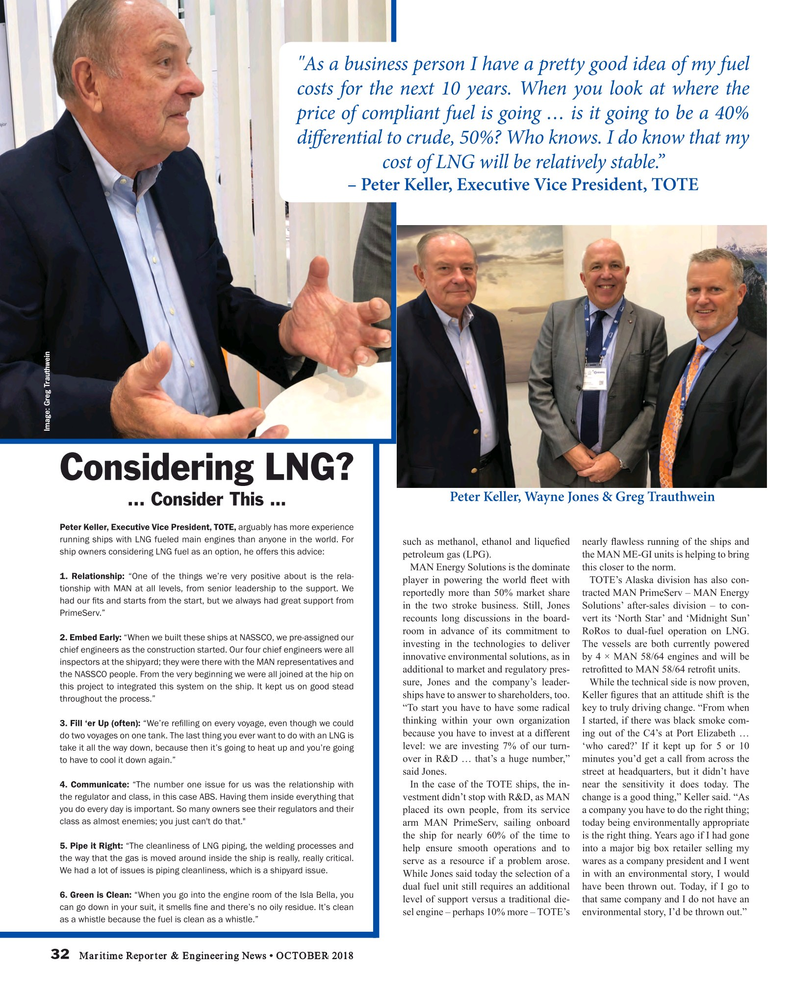
Page 32: of Maritime Reporter Magazine (October 2018)
Marine Design Annual
Read this page in Pdf, Flash or Html5 edition of October 2018 Maritime Reporter Magazine
"As a business person I have a pretty good idea of my fuel costs for the next 10 years. When you look at where the price of compliant fuel is going … is it going to be a 40% dif erential to crude, 50%? Who knows. I do know that my cost of LNG will be relatively stable.” – Peter Keller, Executive Vice President, TOTE
Image: Greg Trauthwein
Considering LNG?
Peter Keller, Wayne Jones & Greg Trauthwein ... Consider This …
Peter Keller, Executive Vice President, TOTE, arguably has more experience running ships with LNG fueled main engines than anyone in the world. For such as methanol, ethanol and lique? ed nearly ? awless running of the ships and ship owners considering LNG fuel as an option, he offers this advice: petroleum gas (LPG). the MAN ME-GI units is helping to bring
MAN Energy Solutions is the dominate this closer to the norm.
1. Relationship: “One of the things we’re very positive about is the rela- player in powering the world ? eet with TOTE’s Alaska division has also con- tionship with MAN at all levels, from senior leadership to the support. We reportedly more than 50% market share tracted MAN PrimeServ – MAN Energy had our ? ts and starts from the start, but we always had great support from in the two stroke business. Still, Jones Solutions’ after-sales division – to con-
PrimeServ.” recounts long discussions in the board- vert its ‘North Star’ and ‘Midnight Sun’ room in advance of its commitment to RoRos to dual-fuel operation on LNG. 2. Embed Early: “When we built these ships at NASSCO, we pre-assigned our investing in the technologies to deliver The vessels are both currently powered chief engineers as the construction started. Our four chief engineers were all innovative environmental solutions, as in by 4 × MAN 58/64 engines and will be inspectors at the shipyard; they were there with the MAN representatives and additional to market and regulatory pres- retro? tted to MAN 58/64 retro? t units. the NASSCO people. From the very beginning we were all joined at the hip on sure, Jones and the company’s leader- While the technical side is now proven, this project to integrated this system on the ship. It kept us on good stead ships have to answer to shareholders, too. Keller ? gures that an attitude shift is the throughout the process.” “To start you have to have some radical key to truly driving change. “From when thinking within your own organization I started, if there was black smoke com- 3. Fill ‘er Up (often): “We’re re? lling on every voyage, even though we could because you have to invest at a different ing out of the C4’s at Port Elizabeth … do two voyages on one tank. The last thing you ever want to do with an LNG is level: we are investing 7% of our turn- ‘who cared?’ If it kept up for 5 or 10 take it all the way down, because then it’s going to heat up and you’re going over in R&D … that’s a huge number,” minutes you’d get a call from across the to have to cool it down again.” said Jones. street at headquarters, but it didn’t have
In the case of the TOTE ships, the in- near the sensitivity it does today. The 4. Communicate: “The number one issue for us was the relationship with the regulator and class, in this case ABS. Having them inside everything that vestment didn’t stop with R&D, as MAN change is a good thing,” Keller said. “As you do every day is important. So many owners see their regulators and their placed its own people, from its service a company you have to do the right thing; class as almost enemies; you just can't do that." arm MAN PrimeServ, sailing onboard today being environmentally appropriate the ship for nearly 60% of the time to is the right thing. Years ago if I had gone 5. Pipe it Right: “The cleanliness of LNG piping, the welding processes and help ensure smooth operations and to into a major big box retailer selling my the way that the gas is moved around inside the ship is really, really critical. serve as a resource if a problem arose. wares as a company president and I went
We had a lot of issues is piping cleanliness, which is a shipyard issue.
While Jones said today the selection of a in with an environmental story, I would dual fuel unit still requires an additional have been thrown out. Today, if I go to 6. Green is Clean: “When you go into the engine room of the Isla Bella, you level of support versus a traditional die- that same company and I do not have an can go down in your suit, it smells ? ne and there’s no oily residue. It’s clean sel engine – perhaps 10% more – TOTE’s environmental story, I’d be thrown out.” as a whistle because the fuel is clean as a whistle.” 32 Maritime Reporter & Engineering News • OCTOBER 2018
MR #10 (26-33).indd 32 MR #10 (26-33).indd 32 10/5/2018 9:19:44 AM10/5/2018 9:19:44 AM

 31
31

 33
33
